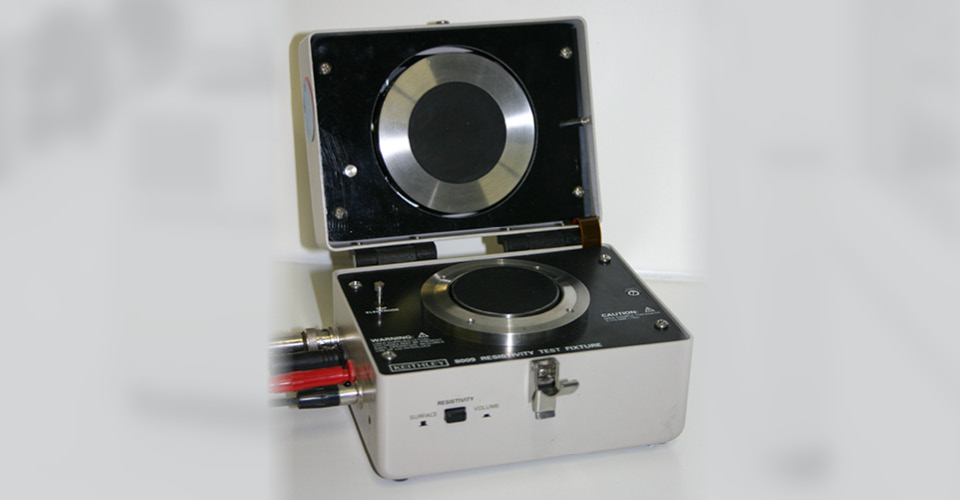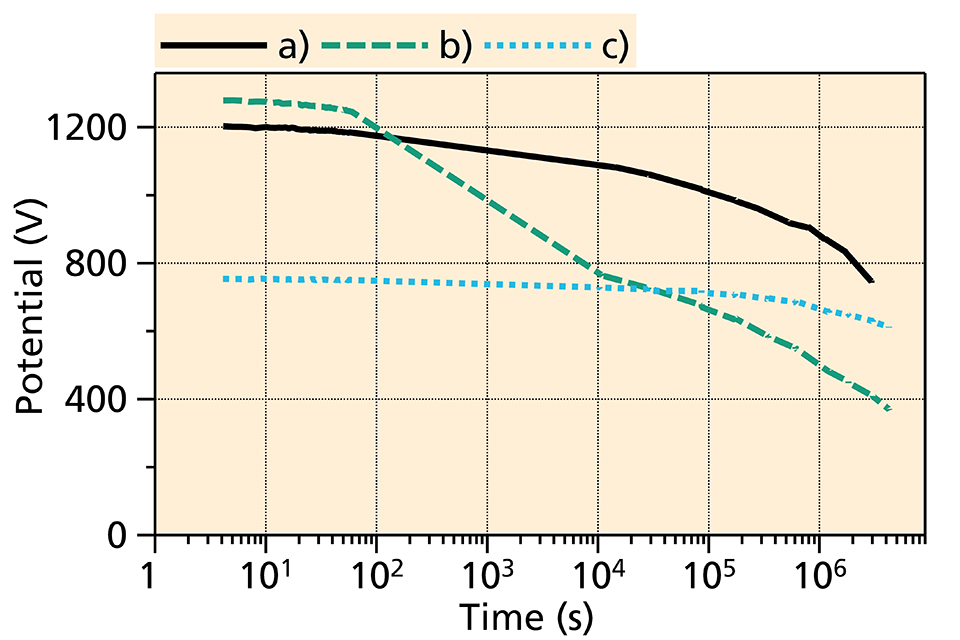Plastics performing for the electrical economy - Fingerprinting the e-performance of polymers


The breakdown voltage or field strength is measured with a high-voltage tester. The specimen is placed between two electrodes. A linearly increasing voltage is applied to these electrodes. Depending on the application, DC voltage (e.g. automotive, solar) or AC voltage (household, industry) is used. The sudden increase in current during a breakdown is registered; the voltage applied at this point is referred to as the breakdown voltage. The breakdown field strength is calculated from this voltage and the thickness of the sample. Typical values are a maximum voltage of 50 kV AC or 70 kV DC, and rates of 0.5 or 1 kV/s.
In the electromobility sector, it is often necessary to verify the dielectric strength. For this purpose, the component is first subjected to a condensation water test or temperature cycling test. Then certain voltage forms are applied to the component and the current flowing is measured with high time resolution (kHz). The corresponding proof is provided if a certain threshold current is not exceeded during the measurement. Typical cornerstones of this test are a trapezoidal voltage waveform with a hold time of 30 s, 100 repetitions, and a maximum voltage of 2700 volts.
The electrical conductivity range of polymers including compounds can vary by more than 16 powers of ten. In the range of very low to medium conductivities, an electrometer together with an electrode assembly with guard ring electrode is used for identification (Fig. 1). The electrometer provides the voltage (up to 1000 V) and can simultaneously detect the current down to a few 100 fA. Since polarization and the trapping of charge carriers contribute to the current flow in addition to the ohmic resistance, the current is measured as a function of time after the voltage is applied. Usually, the current read after 60 s is then used to calculate the specific electrical conductivity. Depending on the arrangement of the electrodes, either the spec. electrical volume conductivity or the surface conductivity can be measured.
In the range of higher conductivities, such as occur with plastics filled with conductive carbon black or graphite, a linear arrangement of four electrodes is used, with the current being fed in via the two outer electrodes and the potential difference being measured at high resistance via the two inner electrodes. In this way, falsification of the measured values due to contact resistance can be largely avoided. The researchers also carry out such measurements as a function of temperature in order to determine the course of electrical conductivity over temperature.
In many parts of industry, electrostatic charging due to friction is a problem, e.g. on conveyor belts, when winding or unwinding rollers, or when moving liquids and bulk materials. To characterize this effect, the Fraunhofer experts periodically guide a friction arm over the sample to be characterized. The friction arm is covered with a plastic fleece. A field probe is used to measure the electrical potential on the sample without contact. After a few friction cycles, the potential no longer increases (the so-called limit charge). After the friction movement is stopped, the subsequent potential drop can also be characterized as a function of time.

In other investigations, the charge is not applied by friction, but with a charge gun. For this purpose, a rod-shaped high-voltage generator in conjunction with a needle electrode or a faki-electrode (several needles) is swung over the sample to be examined. The high-voltage generator produces voltages between -30 kV and -70 kV. Charges are generated that travel to the sample and electrically charge it. After charging, a field probe is swung over the sample, which can record the drop in potential as a function of time. Since the charge decay can take weeks and months for very good polymers, the samples are stored out in the meantime and only measured from time to time. In this way, several samples can be observed in parallel over longer periods of time (Fig. 2). The measurement of dielectric properties (permittivity) or piezoelectric properties is also offered as part of development services.
Plastics often need to be characterized in terms of their electrical properties, whether it is to demonstrate high dielectric strength and good insulation resistance, or to ensure that protection against electrical charge is provided by a certain discharge capability, through to applications where good to very good electrical conductivity must be present. The methods presented here allow a comprehensive characterization of elastomers, thermoplastics and duromers. Due to the wide range of materials and shapes of the components (sheets, tubes, coatings, etc.), specific adaptations of the measurement methods to the customer's needs are often required, which we are happy to work out and implement.